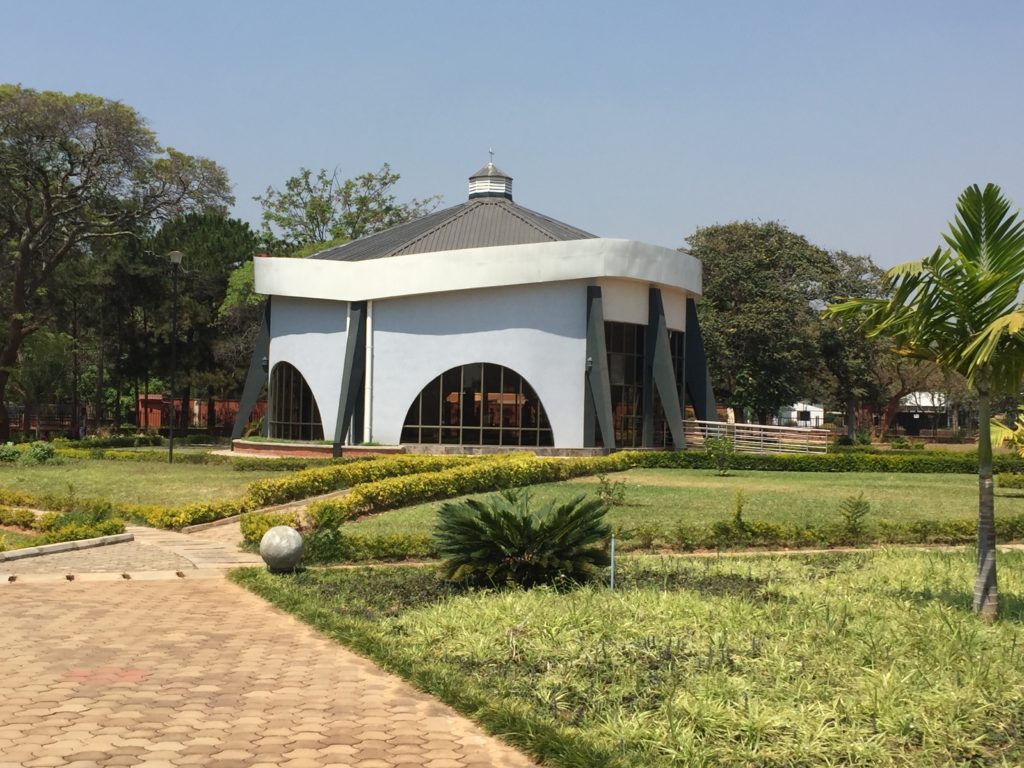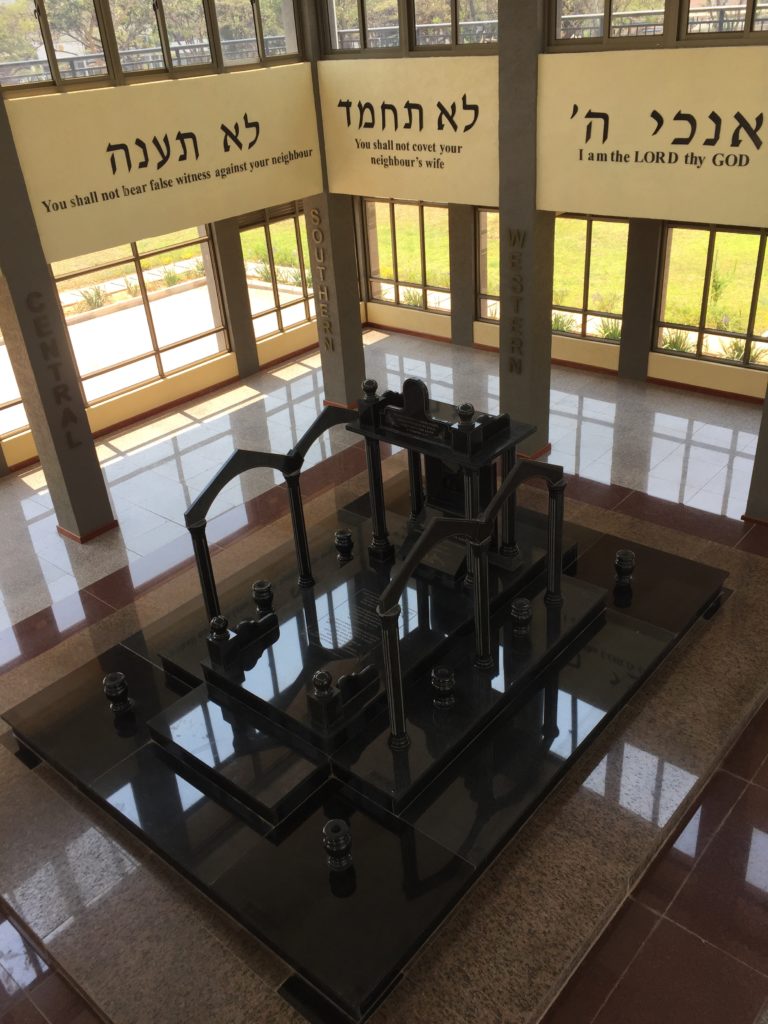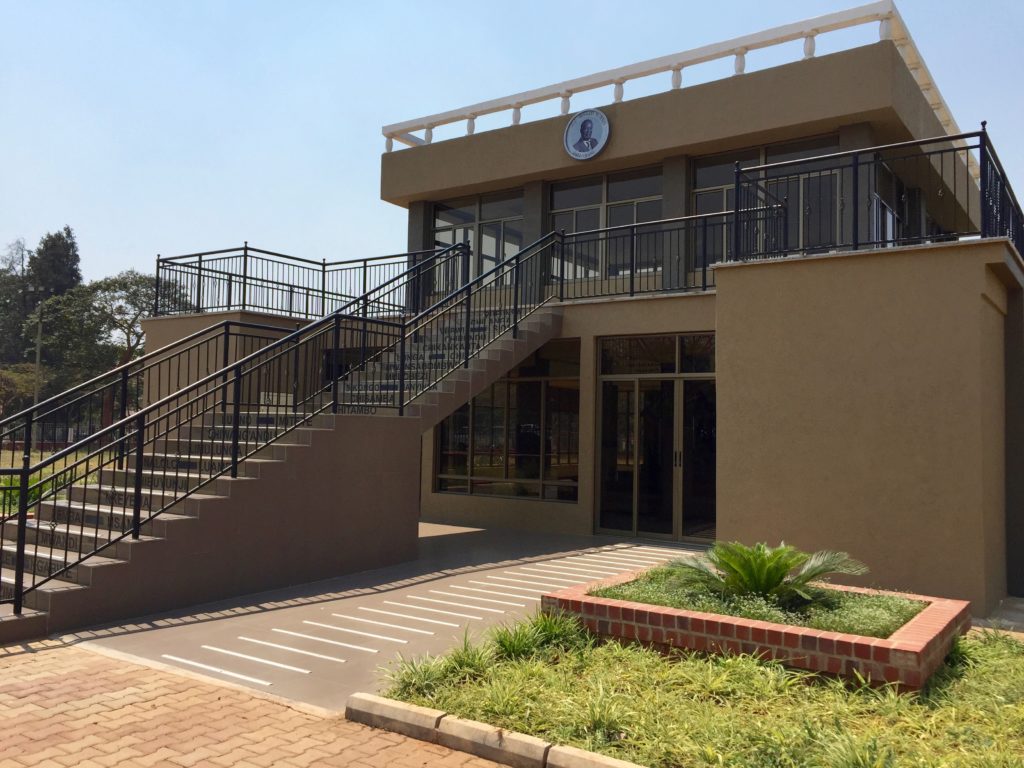The parking lot at Lusaka’s Embassy Park has a lot to recommend it: easy access via Independence Avenue, ample space, some well-placed shade trees, and close proximity to government offices. During fieldwork in Zambia in 2018 I made regular use of this parking lot, crushing fallen jacaranda blossoms beneath my tires as I eased my little grey Toyota into a shady spot. From this location I had an excellent view of Embassy Park’s main attraction: mausolea of the three Zambian heads of state who have died since the country gained independence in 1964 (all other former presidents are still living). The first thing that caught my attention about the mausolea was that only one of them was marked with a cross, something I found surprising, given that Zambia is the only African state to declare that it is a “Christian nation.” Standing next to my car, squinting against the glare of the dry-season sun, I surveyed the three monuments to make sure I was not mistaken. Eventually I caught the eye of the Embassy Park caretaker, who told me that the mausoleum with the cross on top belonged to President Frederick Chiluba, a born-again Pentecostal who was responsible for declaring Zambia a Christian nation soon after his election in 1991.

Chiluba’s mausoleum is meant to look like a chapel from the outside, and the design is convincing—arching windows and pillars, together with the cross on top, make it look like a small church (Figure 1). There are other artistic elements of Chiluba’s mausoleum, but the Christian symbolism predominates; even the air vents in the ceiling above his grave are arranged in the shape of a cross. As far as the image projected by his memorial is concerned, the primary accomplishment of Chiluba’s presidency was “the declaration,” as most Zambians call it. The declaration inspired all kinds of policy decisions under Chiluba, from the establishment of diplomatic relations with Israel to government sponsorship of evangelistic crusades. The declaration also inaugurated a new model of politico-religious power, of which the presidential mausolea provide a literal concrete illustration.
Chiluba’s mausoleum sits to the right of that of President Levy Mwanawasa, the first Zambian head of state to die in office—in fact, the first head of state to die. Mwanawasa’s mausoleum differs significantly from Chiluba’s, as apart from a scripture verse on his headstone there is no Christian symbolism. The architect who designed Mwanawasa’s mausoleum explained to me that he did not employ Christian imagery because Mwanawasa’s faith did not play a major role in his presidency. The same could easily be said of the third man who lies buried at Embassy Park. President Michael Sata was elected in 2011 and died in office in 2014. Like his predecessors, Mwanawasa and later Rupiah Banda, Sata did not take the declaration as a central part of his platform. Indeed, some Zambian Christians viewed him as a threat to the Christian identity of the nation. You would never know this looking at Sata’s mausoleum, however.

The most striking decorative feature of Sata’s mausoleum is the inscription of the Ten Commandments along the interior second floor balcony, written in both Hebrew and English (Figure 2). Giving me a tour of Embassy Park the day after I spoke to him about Chiluba’s cross, the caretaker explained that Sata’s mausoleum was decorated this way because the late president had promised Zambia that he would govern the nation according to the Ten Commandments. This idea provides the organizing motif for the monument, so much so that the epitaph on Sata’s grave is a transcript of his promise, taken from a speech that Sata gave during a mass at St. Ignatius Catholic Church soon after his election. Sata’s presidential portrait depicts him kneeling at the altar at St. Ignatius, presumably during the same mass. While there are other symbolic elements in the mausoleum, they are dominated by Old Testament imagery: in addition to the Hebrew script, the structure is meant to evoke Solomon’s temple (Figure 3).

Sata’s lack of Christian policy initiatives notwithstanding, it is at first glance not unusual that he would be given a memorial that exaggerates the role of religion in his presidency. Memorials are frequent sites of revisionist history, and we could easily say that Sata’s mausoleum is meant to cover up the more unsavory parts of his persona, just as the monument to Chiluba whitewashes the charges of corruption that dogged him his entire life. But in the case of Zambia’s presidential mausolea, we learn less by looking at what they cover up about the past than we do by examining what they reveal about the political present.
In an important recent study, political scientists Elizabeth Sperber and Erin Hern find that African Pentecostals (like the late President Chiluba, as well as some 30 percent of the Zambian electorate), “do not perceive a conflict between the ideal of democracy, on the one hand, and support for Biblical law . . . on the other.” In the Zambian case, “support for Biblical law” crystalizes primarily around a view of the declaration that treats it as a divine covenant between God and the nation. These were precisely the terms first articulated by Chiluba. Standing on the State House lawn at a surprise press conference in December 1991, he declared: “On behalf of the nation, I have now entered into a covenant with the living God.” Through this pronouncement, Chiluba positioned himself in a priestly role, inaugurating a Pentecostal mode of governance in which the president serves as the architect and mediator of a divine agreement, leading the country while also representing it before God. Effectively, what Chiluba created was a hierocracy, rule by politicians who are also priests.
The current Zambian president, Edgar Lungu, has made excellent use of this model, both by taking a priestly role at the newly-created National Day of Prayer, and through a set of policy initiatives aimed at “actualizing” the declaration, including the establishment of a new Ministry of National Guidance and Religious Affairs. This emphasis on the part of the Lungu government helps us understand the design of Sata’s mausoleum, which was constructed during Lungu’s tenure.
In trying to puzzle out how a less-than-devout president wound up with a temple for a tomb, I took my questions to a man I call Harrison Simbaye,1This is a pseudonym. a senior architect in the Zambian Department of Public Infrastructure who had been part of the mausoleum design team. Seated behind a large desk strewn with files, rolled up blueprints, and, at the bottom of a thick stack of papers, a Bible, Mr. Simbaye first relayed that it had been the wish of Sata’s family to construct his mausoleum in the form of the temple. However, he went on, it was also possible to regard the monument as a reflection of what he called “the government of the day.” Seen from this angle, Lungu’s government has used the declaration to reshape recent Zambian political history according to an Old Testament model. Architectural nods to Solomon’s temple, the use of Hebrew writing, the promise of governance according to the Decalogue—and by extension, biblical law more generally—all appeal to an imagined biblical past as the proper mode of governance in the present.
It may be that this particular model of hierocratic governance is characteristic of postcolonial Christian countries that, like Zambia, do not have state churches. In such places, religious and political leadership easily become one in the same, collapsing the distinction between those who are democratically elected and members of the priestly elect. Whether or not this is the case, it is important to acknowledge that within this framework there is ample scope for manipulation. Like Chiluba before him, Lungu has been accused of using Christian ideas to sidestep critique, for example by calling for prayers in the wake of economic downturn, rather than dealing with corruption. Many Zambians I have talked to take these criticisms seriously. Included here are pastors who nevertheless support initiatives like the National Day of Prayer. Those who participate in such politico-religious projects do so because they believe that efforts to actualize the declaration are part of God’s plan for their country. Whether or not the president is sincere in his efforts to (re)commit Zambia to God, they argue, because Lungu is upholding the covenant between God and the nation he is doing God’s work, perhaps in spite of himself. In relating these ideas, church leaders turn again to the Old Testament paradigm, pointing out that God has often used unrighteous leaders to accomplish his purposes. Insofar as this applies to Zambia today, government appeals to the declaration are less about manipulating a Christian electorate and more about understanding that for a large swathe of the Zambian public the most important political task is keeping God on the side of the nation.
All images courtesy of the author.











